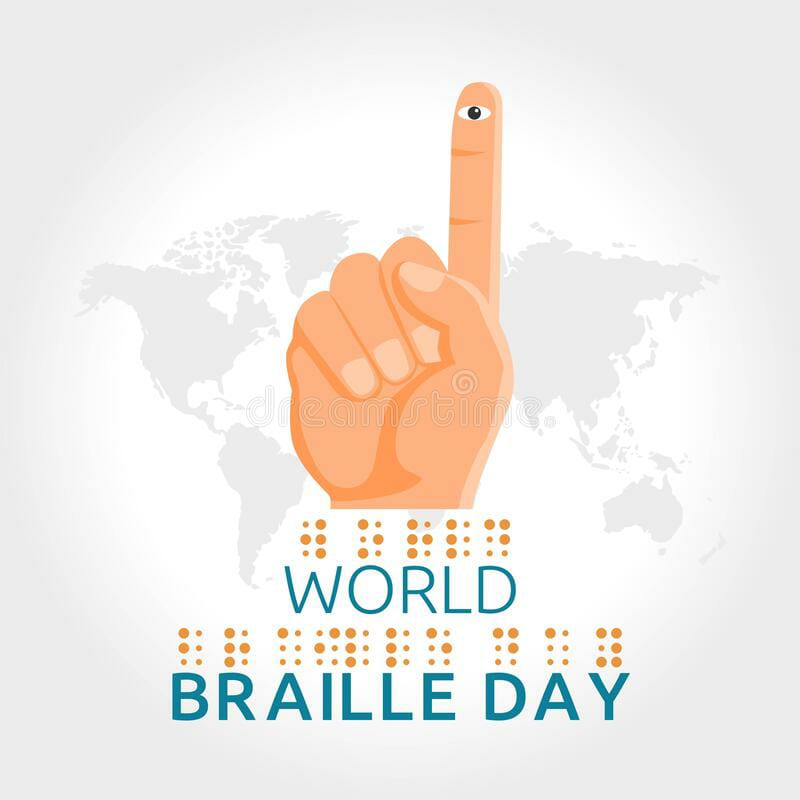WORLD BRAILLE DAY
565 total views, 1 views today

We can hear. We can speak. We can walk. We can talk. We can touch. We can smell.
&
WE CAN SEE.
How blessed are we, isn’t it? But there are so many people out there who have this disability of vision. There are children who want to read, write, play, but everything is restricted. Everyone has dreams and aspirations, and imagine how difficult it can be to be visually impaired. But the passion for making something worthwhile out of their lives is far too strong than their afflictions, or challenges.
So, read along!
It’s World Braille Day, and it’s time to celebrate! I’m sure you guessed it’s a day dedicated to braille. But you might be wondering what it’s all about and why it’s so important to commemorate. So, let’s talk about it so that we can get the word out and invite more people to the party!
Today is the birthday of Louis Braille. He’s the man who invented braille! Louis was born in France in 1809 and was blinded as a result of a childhood accident. But he rapidly adapted to his new lifestyle. Louis designed a reading and writing technique based on Charles Barbier’s night writing system while he was just 15 years old. Louis’ system is now known as braille. Braille has been improved through time and is currently used all around the world! Unfortunately, Louis Braille was never able to see how useful his innovation was. He died in 1852, two years before the Royal Institute for the Blind Youth in France adopted a braille curriculum. Braille was taught to blind pupils in schools across the United States by 1916.
On January 4, World Braille Day is observed around the world to raise awareness of the importance of braille as a means of communication in the full achievement of human rights for the blind and visually impaired.
“Even under normal conditions, those with disabilities—one billion people worldwide—are less likely to receive health care, education, employment, and community participation,” was the topic of World Braille Day in 2021. Although this year’s theme for the day has not been announced yet.
Blind and partially sighted people who learn braille can enjoy reading for the rest of their lives. Learning braille at a young age is very beneficial for literacy because it is a far better way to understand punctuation, syntax, and spelling than audio. Braille is one incredible invention that has sparked hope in the eyes of many. Passing one’s fingertips over an arrangement of one to six embossed dots that represent letters, numbers, musical and mathematical symbols is how Braille is read. Braille can be written on paper with a Braillewriter, which is comparable to a typewriter, or with a pointed stylus and a Braille slate. People with visual impairments used to read using the Haüy technique, which entailed embossing Latin letters on leather or thick paper.
If you’re losing your vision but still have some vision when you start, it’s suggested that you learn braille via touch. It will only be useful as a tactile code if you can read and write it with your hands if your vision is fully lost or you can no longer read a huge type. Braille takes up a lot more room on a page than sighted writing. Contracted braille is in which a braille cell represents a whole word or part of a word, is the most common approach for saving space and speeding up reading and writing.
People with visual difficulties have experienced many issues in terms of isolation and independence as a result of the coronavirus lockdowns around the world. Because many persons with disabilities are at a higher risk of getting COVID-19 due to a lack of guidelines, the pandemic has also highlighted the significance of making information more accessible, especially in Braille and on audio platforms, so that everyone can get crucial information to protect themselves and help stop COVID-19 from spreading.
According to the World Health Organization, around one billion people suffer from a distant or near vision impairment that could have been avoided or is still unaddressed. It was highlighted by WHO that People with visual disabilities will only be able to fully realize their fundamental freedoms if they are provided with inclusion, which includes recognition of Braille as a medium of instruction.
Electronic braille notetakers and refreshable braille displays now allow blind and visually impaired people who know braille to browse the internet, read webpages and email, as well as store and update their own written work. Rubix cubes, watches, Lego-style bricks, and other innovations are transforming the way we use braille today, as well as helping to boost braille literacy. That’s why you’ll see braille on signs, ATMs, elevators, calculators, and other everyday items. All of this is due to Louis Braille and the schools who adopted and taught his reading and writing system.
The touch sensitivity required for braille can take some time to develop. This could make learning braille more challenging as you become older or if you have other health issues that influence finger sensitivity. The decision to learn and use braille as an adult is largely based on personal desire. Someone who loses their sight as an adult, for example, may want to use digital assistive technology such as screen readers, video magnifiers, and recorders. Learning braille, on the other hand, has major literacy benefits that can provide greater flexibility and independence. It is quite valuable in the workplace for many blind and visually impaired people. Deafblind people are unable to use audio formats, making braille all the more crucial.
On World Braille Day, one should raise awareness about the difficulties that visually impaired individuals encounter. Today, we should renew our dedication to the cause, ensuring that blind people’s lives are free of obstacles and that they can live fulfilling lives as persons and as citizens. Let us, as individuals, empower the visually impaired and make a difference in their lives.
Happy International Braille Day!
